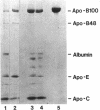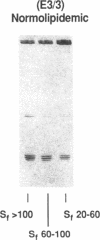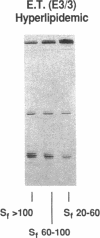Abstract
The physical, chemical, and receptor binding properties of very low density lipoprotein (VLDL) fractions from familial dysbetalipoproteinemic (dys-beta) subjects, homozygous for apolipoprotein (apo-) E2 (E2/2 phenotype), and subjects with the E3/3 phenotype were studied to gain insights into the pathogenesis of dysbetalipoproteinemia, a disorder characterized by the presence of beta-VLDL in the plasma. Pre-beta-VLDL from dys-beta subjects were larger (27 vs. 17 x 10(6) D) and more triglyceride rich (68 vs. 43% dry weight) than beta-VLDL. Pre-beta-VLDL predominated in the Sf greater than 100 flotation fraction, whereas beta-VLDL predominated in the Sf 20-60 fraction. Because lipolysis converts large VLDL (Sf greater than 100) in vivo to smaller, more cholesteryl ester-rich VLDL (Sf 20-60), it is likely that pre-beta-VLDL are precursors of beta-VLDL. Although beta-VLDL were not found in type V hyperlipidemic E3/3 subjects, they were induced by intravenous heparinization, suggesting that lipolysis of pre-beta-VLDL in vivo can result in beta-VLDL formation. Similarly, heparinization of a dys-beta subject produced more beta-VLDL, at the expense of pre-beta-VLDL. The pre-beta-VLDL from normolipidemic and type V hyperlipidemic E3/3 subjects, respectively, had 90 and 280 times the affinity for the apo-B,E(LDL) receptor than did the pre-beta-VLDL from dys-beta subjects. Heparin-induced beta-VLDL from type V hyperlipidemic subjects had a sixfold higher binding affinity than did heparin-induced beta-VLDL from dys-beta subjects. These data suggest that pre-beta-VLDL from E2/2 subjects interact poorly with lipoprotein receptors in vivo, decreasing their receptor-mediated clearance and increasing their conversion to beta-VLDL during lipolytic processing.
Full text
PDF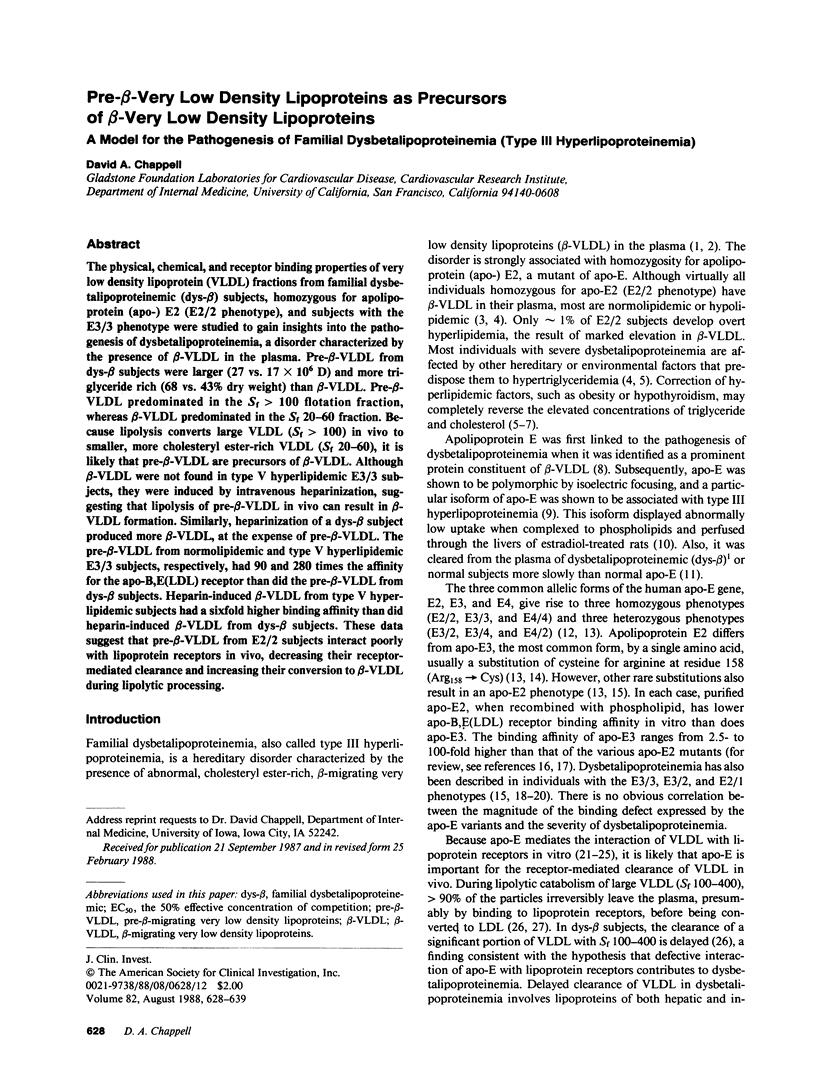
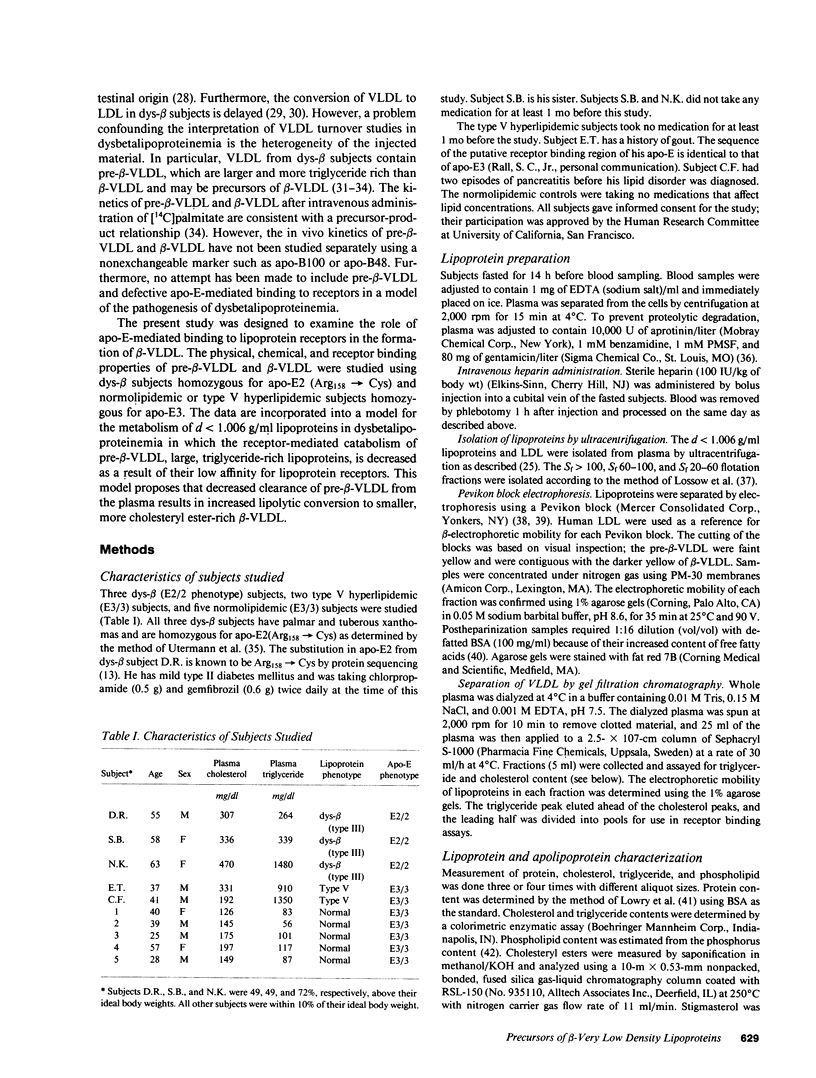
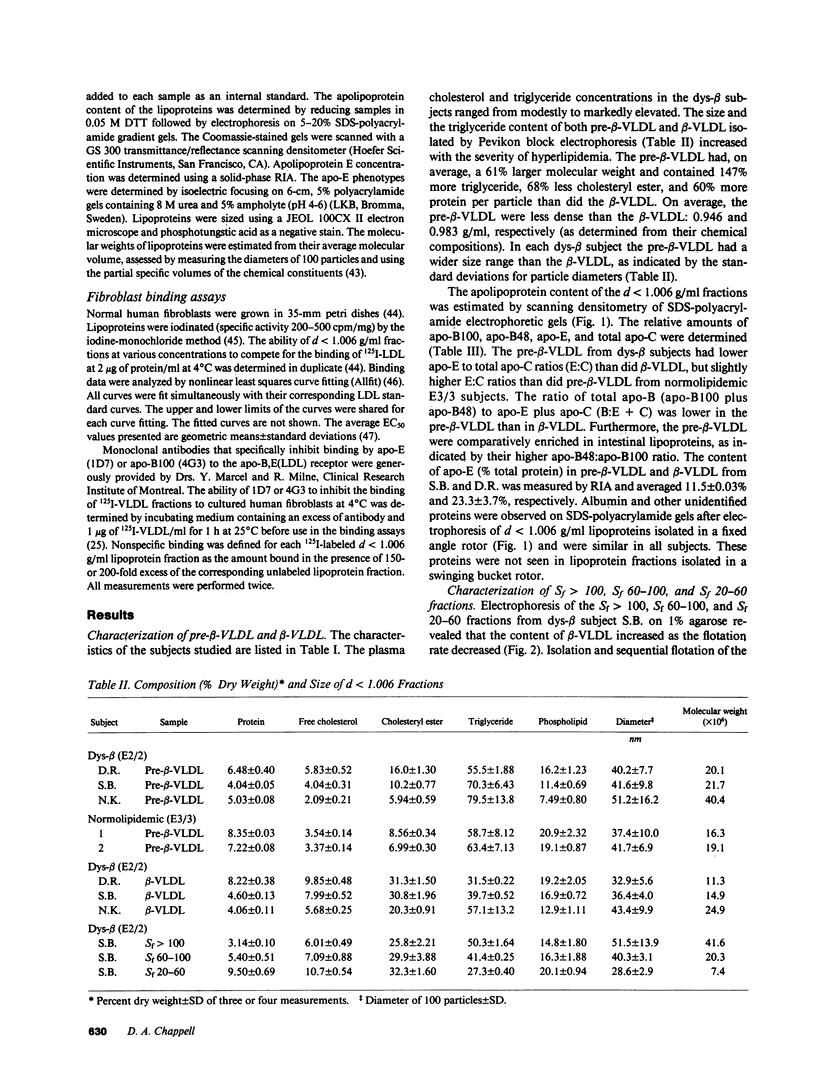
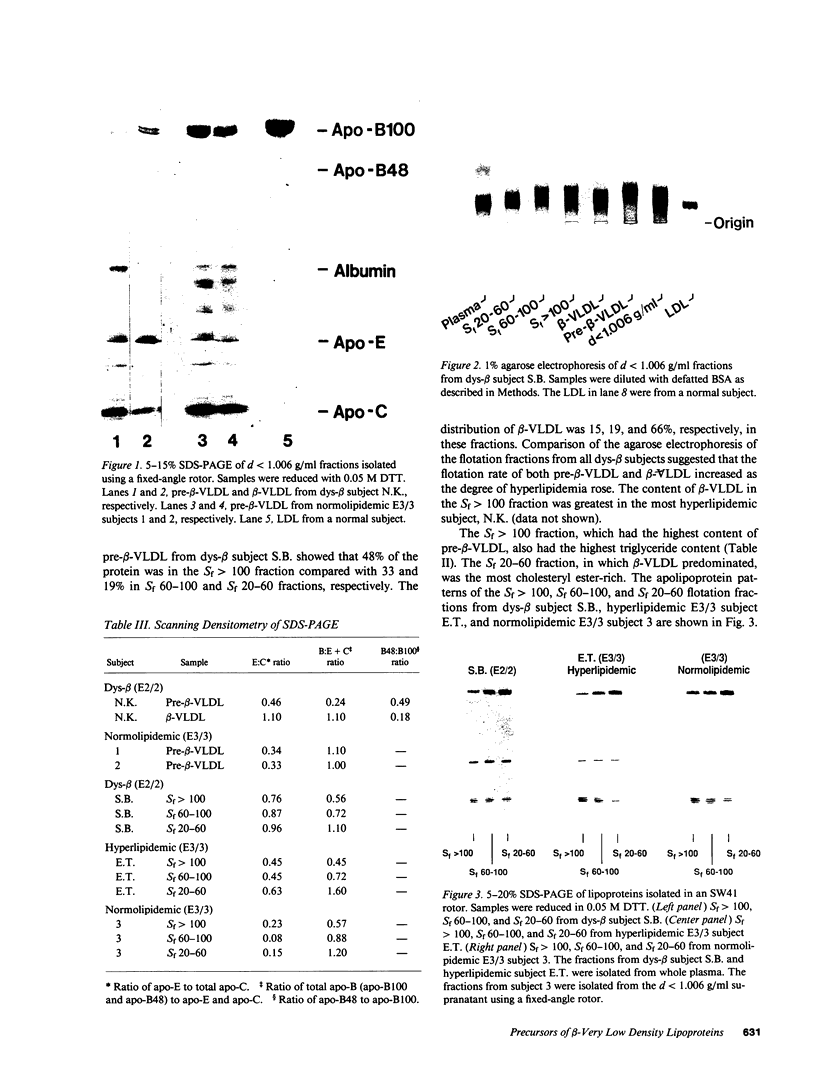
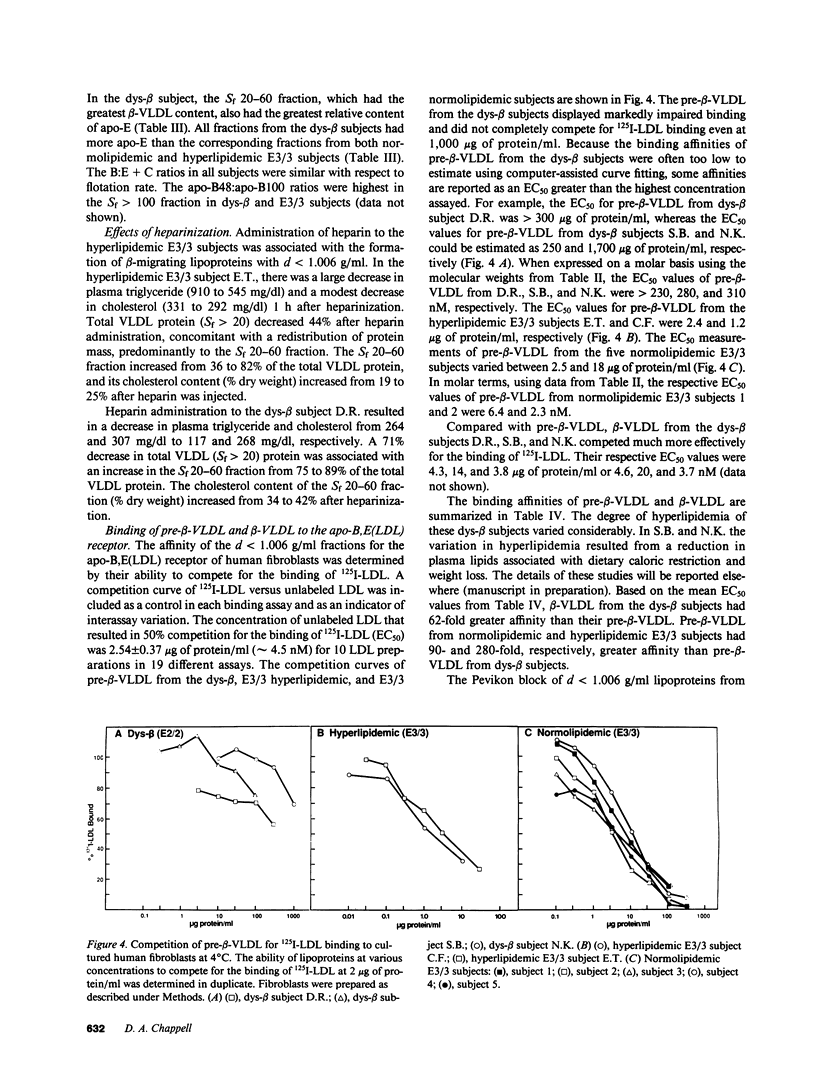
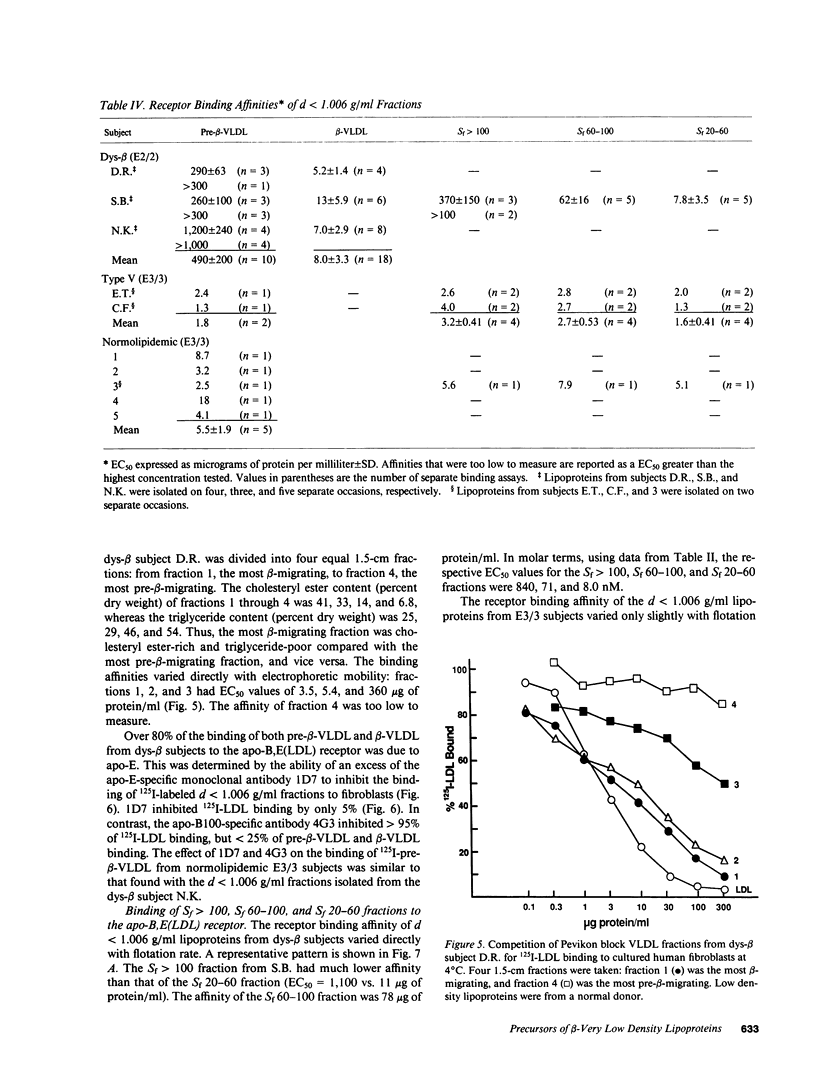
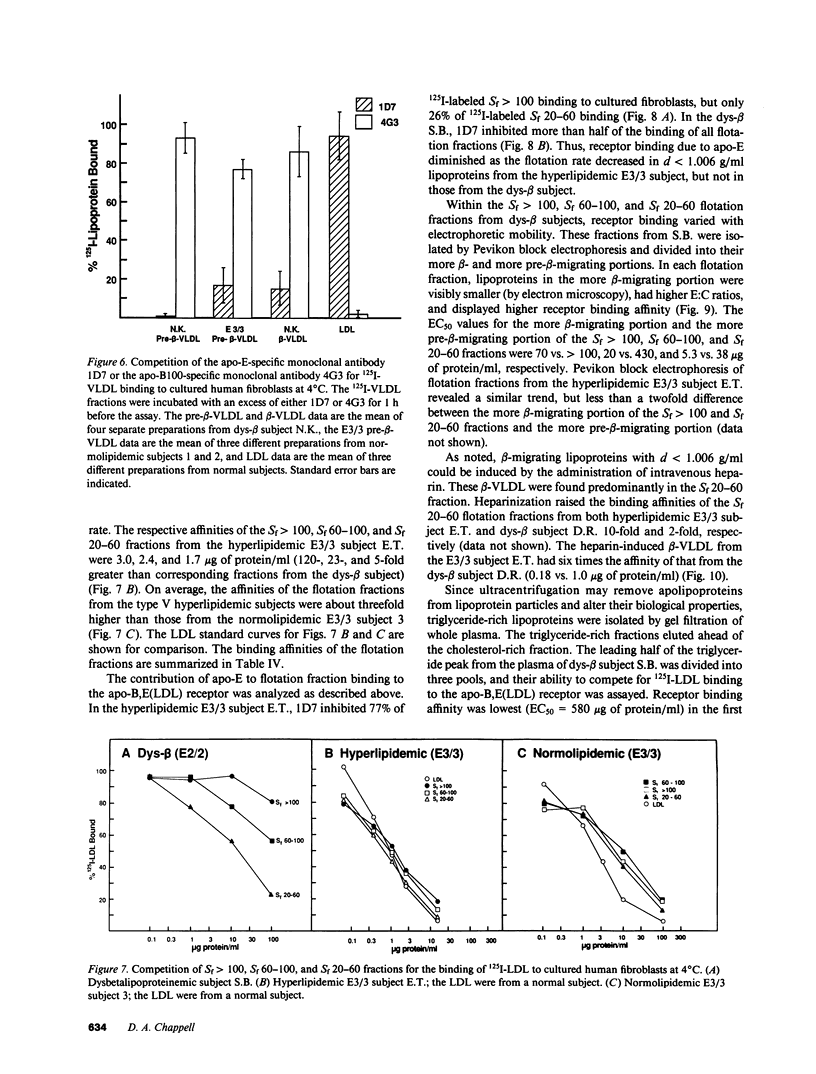
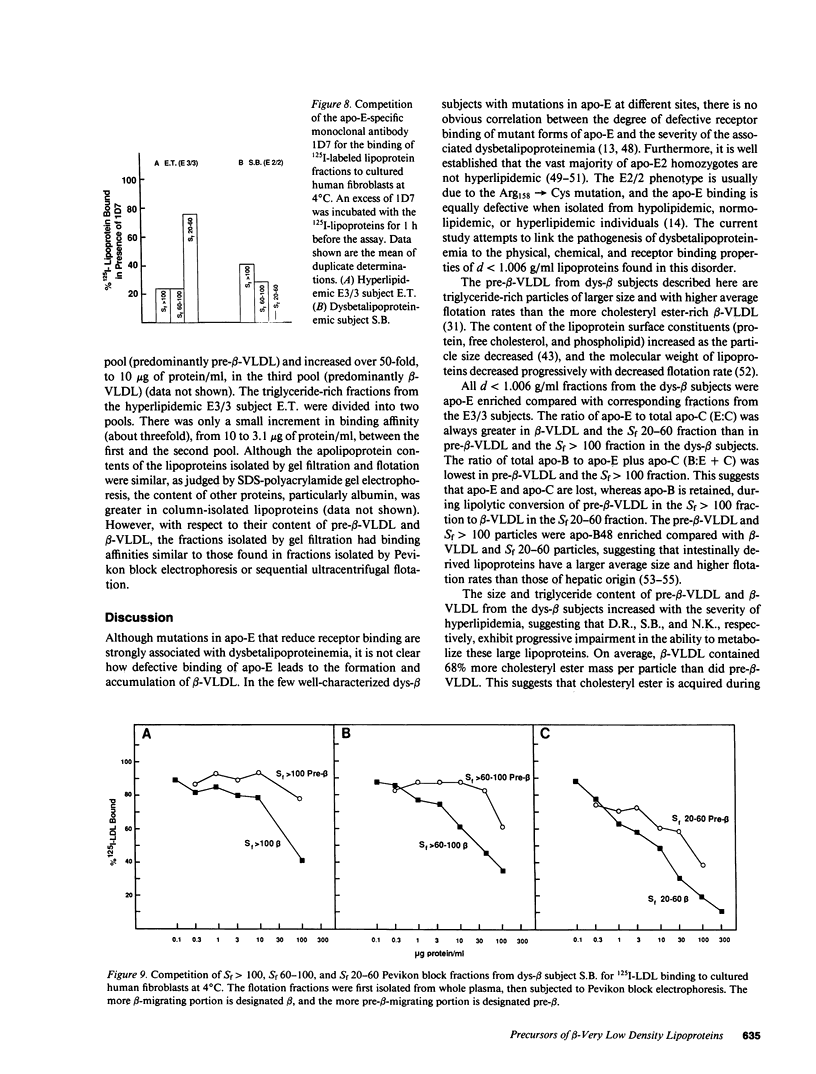
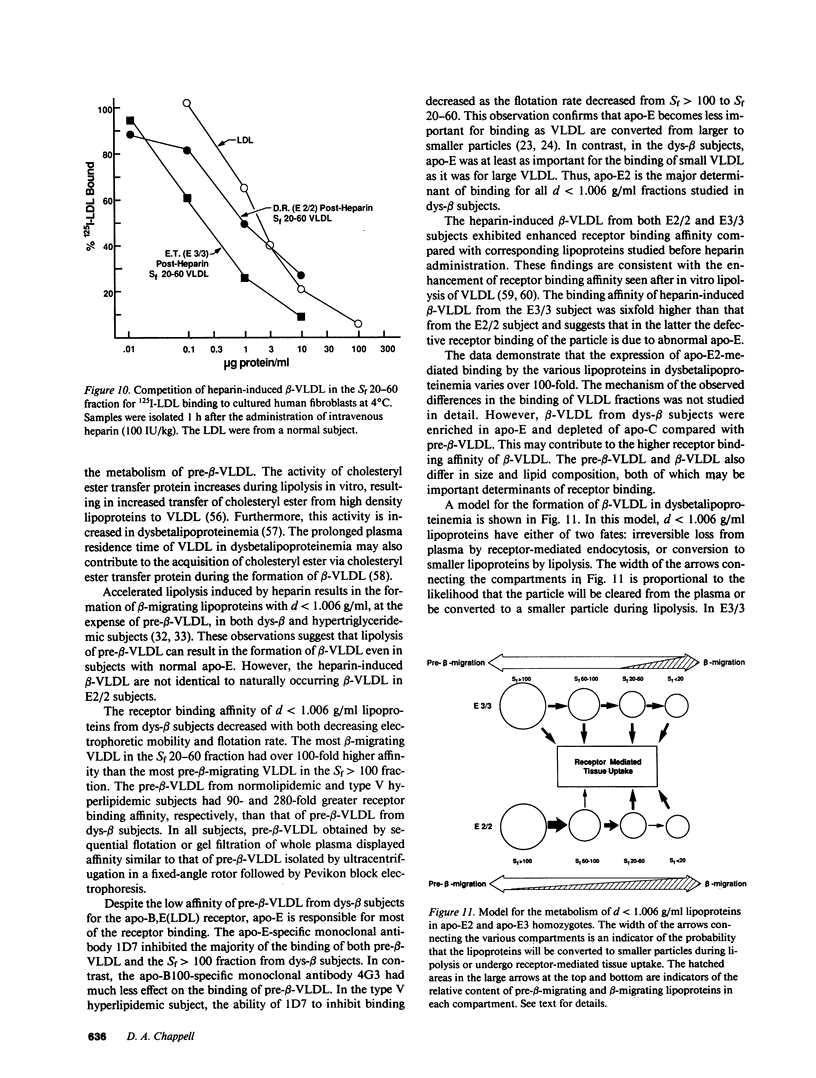
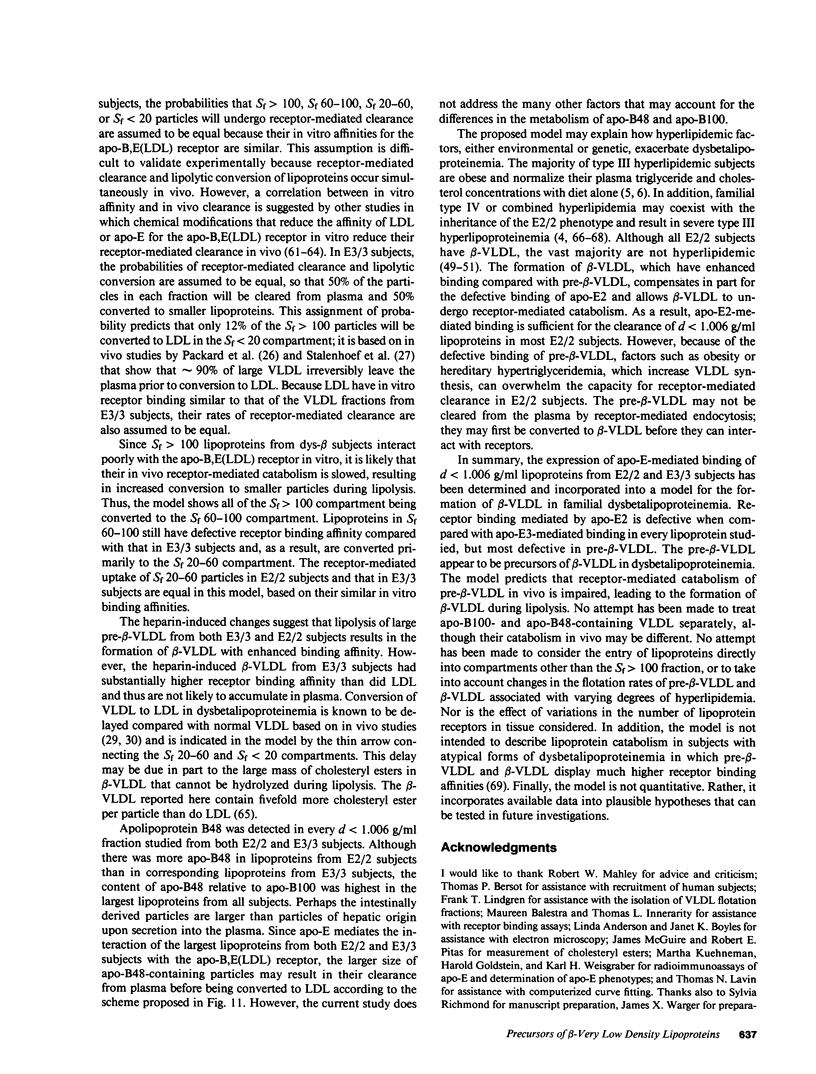
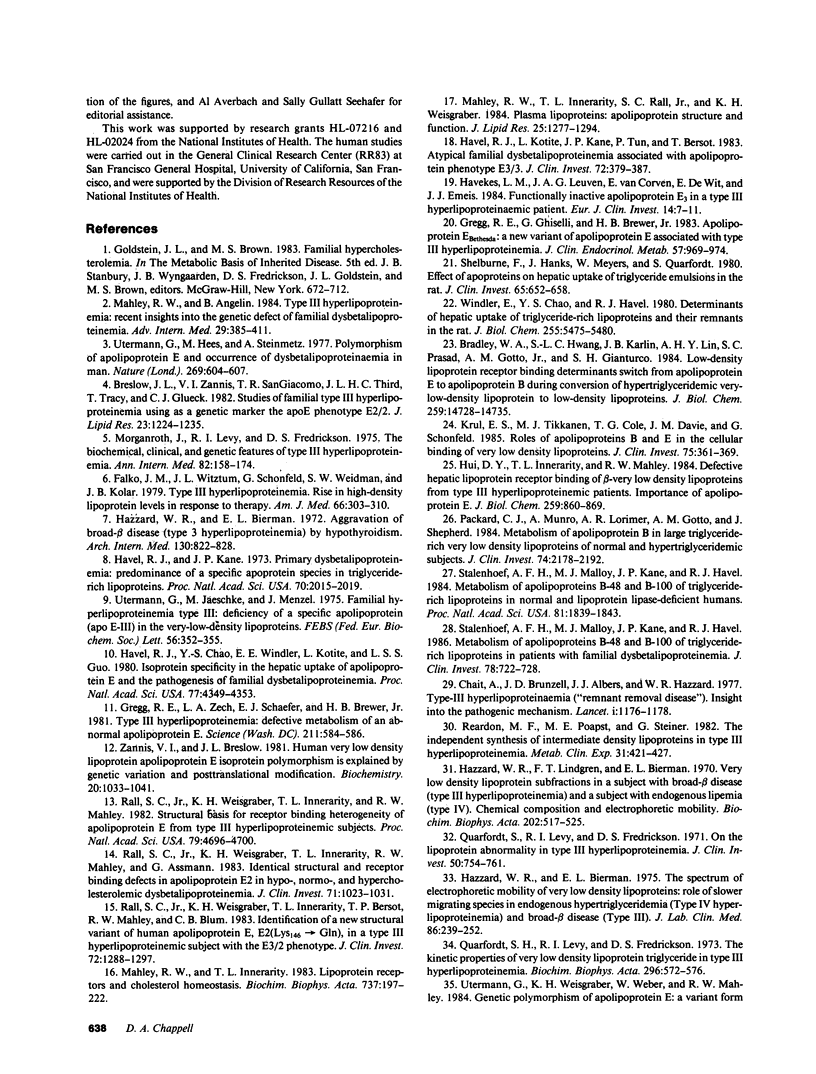
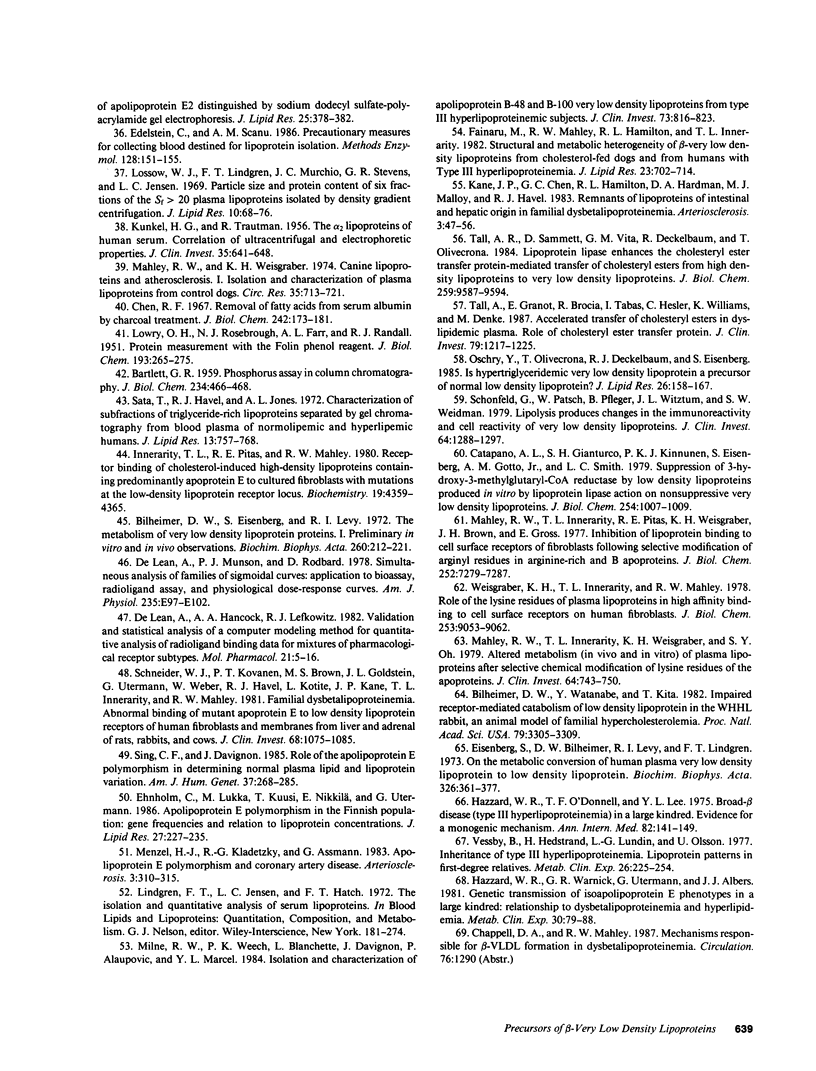
Images in this article
Selected References
These references are in PubMed. This may not be the complete list of references from this article.
- BARTLETT G. R. Phosphorus assay in column chromatography. J Biol Chem. 1959 Mar;234(3):466–468. [PubMed] [Google Scholar]
- Bilheimer D. W., Eisenberg S., Levy R. I. The metabolism of very low density lipoprotein proteins. I. Preliminary in vitro and in vivo observations. Biochim Biophys Acta. 1972 Feb 21;260(2):212–221. doi: 10.1016/0005-2760(72)90034-3. [DOI] [PubMed] [Google Scholar]
- Bilheimer D. W., Watanabe Y., Kita T. Impaired receptor-mediated catabolism of low density lipoprotein in the WHHL rabbit, an animal model of familial hypercholesterolemia. Proc Natl Acad Sci U S A. 1982 May;79(10):3305–3309. doi: 10.1073/pnas.79.10.3305. [DOI] [PMC free article] [PubMed] [Google Scholar]
- Bradley W. A., Hwang S. L., Karlin J. B., Lin A. H., Prasad S. C., Gotto A. M., Jr, Gianturco S. H. Low-density lipoprotein receptor binding determinants switch from apolipoprotein E to apolipoprotein B during conversion of hypertriglyceridemic very-low-density lipoprotein to low-density lipoproteins. J Biol Chem. 1984 Dec 10;259(23):14728–14735. [PubMed] [Google Scholar]
- Breslow J. L., Zannis V. I., SanGiacomo T. R., Third J. L., Tracy T., Glueck C. J. Studies of familial type III hyperlipoproteinemia using as a genetic marker the apoE phenotype E2/2. J Lipid Res. 1982 Nov;23(8):1224–1235. [PubMed] [Google Scholar]
- Catapano A. L., Gianturco S. H., Kinnunen P. K., Eisenberg S., Gotto A. M., Jr, Smith L. C. Suppression of 3-hydroxy-3-methylglutaryl-CoA reductase by low density lipoproteins produced in vitro by lipoprotein lipase action on nonsuppressive very low density lipoproteins. J Biol Chem. 1979 Feb 25;254(4):1007–1009. [PubMed] [Google Scholar]
- Chait A., Brunzell J. D., Albers J. J., Hazzard W. R. Type-III Hyperlipoproteinaemia ("remnant removal disease"). Insight into the pathogenetic mechanism. Lancet. 1977 Jun 4;1(8023):1176–1178. doi: 10.1016/s0140-6736(77)92717-9. [DOI] [PubMed] [Google Scholar]
- Chen R. F. Removal of fatty acids from serum albumin by charcoal treatment. J Biol Chem. 1967 Jan 25;242(2):173–181. [PubMed] [Google Scholar]
- De Lean A., Hancock A. A., Lefkowitz R. J. Validation and statistical analysis of a computer modeling method for quantitative analysis of radioligand binding data for mixtures of pharmacological receptor subtypes. Mol Pharmacol. 1982 Jan;21(1):5–16. [PubMed] [Google Scholar]
- DeLean A., Munson P. J., Rodbard D. Simultaneous analysis of families of sigmoidal curves: application to bioassay, radioligand assay, and physiological dose-response curves. Am J Physiol. 1978 Aug;235(2):E97–102. doi: 10.1152/ajpendo.1978.235.2.E97. [DOI] [PubMed] [Google Scholar]
- Edelstein C., Scanu A. M. Precautionary measures for collecting blood destined for lipoprotein isolation. Methods Enzymol. 1986;128:151–155. doi: 10.1016/0076-6879(86)28065-9. [DOI] [PubMed] [Google Scholar]
- Ehnholm C., Lukka M., Kuusi T., Nikkilä E., Utermann G. Apolipoprotein E polymorphism in the Finnish population: gene frequencies and relation to lipoprotein concentrations. J Lipid Res. 1986 Mar;27(3):227–235. [PubMed] [Google Scholar]
- Eisenberg S., Bilheimer D. W., Levy R. I., Lindgren F. T. On the metabolic conversion of human plasma very low density lipoprotein to low density lipoprotein. Biochim Biophys Acta. 1973 Dec 20;326(3):361–377. doi: 10.1016/0005-2760(73)90138-0. [DOI] [PubMed] [Google Scholar]
- Fainaru M., Mahley R. W., Hamilton R. L., Innerarity T. L. Structural and metabolic heterogeneity of beta-very low density lipoproteins from cholesterol-fed dogs and from humans with type III hyperlipoproteinemia. J Lipid Res. 1982 Jul;23(5):702–714. [PubMed] [Google Scholar]
- Falko J. M., Witztum J. L., Schonfeld G., Weidman S. W., Kolar J. B. Type III hyperlipoproteinemia: rise in high-density lipoprotein levels in response to therapy. Am J Med. 1979 Feb;66(2):303–310. doi: 10.1016/0002-9343(79)90553-9. [DOI] [PubMed] [Google Scholar]
- Gregg R. E., Ghiselli G., Brewer H. B., Jr Apolipoprotein EBethesda: a new variant of apolipoprotein E associated with type III hyperlipoproteinemia. J Clin Endocrinol Metab. 1983 Nov;57(5):969–974. doi: 10.1210/jcem-57-5-969. [DOI] [PubMed] [Google Scholar]
- Gregg R. E., Zech L. A., Schaefer E. J., Brewer H. B., Jr Type III hyperlipoproteinemia: defective metabolism of an abnormal apolipoprotein E. Science. 1981 Feb 6;211(4482):584–586. doi: 10.1126/science.7455696. [DOI] [PubMed] [Google Scholar]
- Havekes L. M., Gevers Leuven J. A., van Corven E., de Wit E., Emeis J. J. Functionally inactive apolipoprotein E3 in a type III hyperlipoproteinaemic patient. Eur J Clin Invest. 1984 Feb;14(1):7–11. doi: 10.1111/j.1365-2362.1984.tb00696.x. [DOI] [PubMed] [Google Scholar]
- Havel R. J., Chao Y., Windler E. E., Kotite L., Guo L. S. Isoprotein specificity in the hepatic uptake of apolipoprotein E and the pathogenesis of familial dysbetalipoproteinemia. Proc Natl Acad Sci U S A. 1980 Jul;77(7):4349–4353. doi: 10.1073/pnas.77.7.4349. [DOI] [PMC free article] [PubMed] [Google Scholar]
- Havel R. J., Kane J. P. Primary dysbetalipoproteinemia: predominance of a specific apoprotein species in triglyceride-rich lipoproteins. Proc Natl Acad Sci U S A. 1973 Jul;70(7):2015–2019. doi: 10.1073/pnas.70.7.2015. [DOI] [PMC free article] [PubMed] [Google Scholar]
- Havel R. J., Kotite L., Kane J. P., Tun P., Bersot T. Atypical familial dysbetalipoproteinemia associated with apolipoprotein phenotype E3/3. J Clin Invest. 1983 Jul;72(1):379–387. doi: 10.1172/JCI110978. [DOI] [PMC free article] [PubMed] [Google Scholar]
- Hazzard E. R., Bierman E. L. The spectrum of electrophoretic mobility of very low density lipoproteins: role of slower migrating species in endogenous hypertriglyceridemia (type IV hyperlipoproteinemia) and broad-beta disease (type III). J Lab Clin Med. 1975 Aug;86(2):239–252. [PubMed] [Google Scholar]
- Hazzard W. R., Bierman E. L. Aggravation of broad- disease (type 3 hyperlipoproteinemia) by hypothyroidism. Arch Intern Med. 1972 Dec;130(6):822–828. [PubMed] [Google Scholar]
- Hazzard W. R., Lindgren F. T., Bierman E. L. Very low density lipoprotein subfractions in a subject with broad-beta disease (Type 3 hyperlipoproteinemia) and a subject with endogenous lipemia (Type IV). Chemical composition and electrophoretic mobility. Biochim Biophys Acta. 1970 May 5;202(3):517–525. doi: 10.1016/0005-2760(70)90122-0. [DOI] [PubMed] [Google Scholar]
- Hazzard W. R., O'Donnell T. F., Lee Y. L. Broad-beta disease (type III hyperlipoproteinemia) in a large kindred. Evidence for a monogenic mechanism. Ann Intern Med. 1975 Feb;82(2):141–149. doi: 10.7326/0003-4819-82-2-141. [DOI] [PubMed] [Google Scholar]
- Hazzard W. R., Warnick G. R., Utermann G., Albers J. J. Genetic transmission of isoapolipoprotein E phenotypes in a large kindred: relationship to dysbetalipoproteinemia and hyperlipidemia. Metabolism. 1981 Jan;30(1):79–88. doi: 10.1016/0026-0495(81)90223-7. [DOI] [PubMed] [Google Scholar]
- Hui D. Y., Innerarity T. L., Mahley R. W. Defective hepatic lipoprotein receptor binding of beta-very low density lipoproteins from type III hyperlipoproteinemic patients. Importance of apolipoprotein E. J Biol Chem. 1984 Jan 25;259(2):860–869. [PubMed] [Google Scholar]
- Innerarity T. L., Pitas R. E., Mahley R. W. Receptor binding of cholesterol-induced high-density lipoproteins containing predominantly apoprotein E to cultured fibroblasts with mutations at the low-density lipoprotein receptor locus. Biochemistry. 1980 Sep 2;19(18):4359–4365. doi: 10.1021/bi00559a032. [DOI] [PubMed] [Google Scholar]
- KUNKEL H. G., TRAUTMAN R. The alpha2 lipoproteins of human serum; correlation of ultracentrifugal and electrophoretic properties. J Clin Invest. 1956 Jun;35(6):641–648. doi: 10.1172/JCI103320. [DOI] [PMC free article] [PubMed] [Google Scholar]
- Kane J. P., Chen G. C., Hamilton R. L., Hardman D. A., Malloy M. J., Havel R. J. Remnants of lipoproteins of intestinal and hepatic origin in familial dysbetalipoproteinemia. Arteriosclerosis. 1983 Jan-Feb;3(1):47–56. doi: 10.1161/01.atv.3.1.47. [DOI] [PubMed] [Google Scholar]
- Krul E. S., Tikkanen M. J., Cole T. G., Davie J. M., Schonfeld G. Roles of apolipoproteins B and E in the cellular binding of very low density lipoproteins. J Clin Invest. 1985 Feb;75(2):361–369. doi: 10.1172/JCI111708. [DOI] [PMC free article] [PubMed] [Google Scholar]
- LOWRY O. H., ROSEBROUGH N. J., FARR A. L., RANDALL R. J. Protein measurement with the Folin phenol reagent. J Biol Chem. 1951 Nov;193(1):265–275. [PubMed] [Google Scholar]
- Lossow W. J., Lindgren F. T., Murchio J. C., Stevens G. R., Jensen L. C. Particle size and protein content of six fractions of the Sf 20 plasma lipoproteins isolated by density gradient centrifugation. J Lipid Res. 1969 Jan;10(1):68–76. [PubMed] [Google Scholar]
- Mahley R. W., Angelin B. Type III hyperlipoproteinemia: recent insights into the genetic defect of familial dysbetalipoproteinemia. Adv Intern Med. 1984;29:385–411. [PubMed] [Google Scholar]
- Mahley R. W., Innerarity T. L. Lipoprotein receptors and cholesterol homeostasis. Biochim Biophys Acta. 1983 May 24;737(2):197–222. doi: 10.1016/0304-4157(83)90001-1. [DOI] [PubMed] [Google Scholar]
- Mahley R. W., Innerarity T. L., Pitas R. E., Weisgraber K. H., Brown J. H., Gross E. Inhibition of lipoprotein binding to cell surface receptors of fibroblasts following selective modification of arginyl residues in arginine-rich and B apoproteins. J Biol Chem. 1977 Oct 25;252(20):7279–7287. [PubMed] [Google Scholar]
- Mahley R. W., Innerarity T. L., Weisgraber K. B., Oh S. Y. Altered metabolism (in vivo and in vitro) of plasma lipoproteins after selective chemical modification of lysine residues of the apoproteins. J Clin Invest. 1979 Sep;64(3):743–750. doi: 10.1172/JCI109518. [DOI] [PMC free article] [PubMed] [Google Scholar]
- Mahley R. W., Weisgraber K. H. Canine lipoproteins and atherosclerosis. I. Isolation and characterization of plasma lipoproteins from control dogs. Circ Res. 1974 Nov;35(5):713–721. doi: 10.1161/01.res.35.5.713. [DOI] [PubMed] [Google Scholar]
- Menzel H. J., Kladetzky R. G., Assmann G. Apolipoprotein E polymorphism and coronary artery disease. Arteriosclerosis. 1983 Jul-Aug;3(4):310–315. doi: 10.1161/01.atv.3.4.310. [DOI] [PubMed] [Google Scholar]
- Milne R. W., Weech P. K., Blanchette L., Davignon J., Alaupovic P., Marcel Y. L. Isolation and characterization of apolipoprotein B-48 and B-100 very low density lipoproteins from type III hyperlipoproteinemic subjects. J Clin Invest. 1984 Mar;73(3):816–823. doi: 10.1172/JCI111276. [DOI] [PMC free article] [PubMed] [Google Scholar]
- Morganroth J., Levy R. I., Fredrickson D. S. The biochemical, clinical, and genetic features of type III hyperlipoproteinemia. Ann Intern Med. 1975 Feb;82(2):158–174. doi: 10.7326/0003-4819-82-2-158. [DOI] [PubMed] [Google Scholar]
- Oschry Y., Olivecrona T., Deckelbaum R. J., Eisenberg S. Is hypertriglyceridemic very low density lipoprotein a precursor of normal low density lipoprotein? J Lipid Res. 1985 Feb;26(2):158–167. [PubMed] [Google Scholar]
- Packard C. J., Munro A., Lorimer A. R., Gotto A. M., Shepherd J. Metabolism of apolipoprotein B in large triglyceride-rich very low density lipoproteins of normal and hypertriglyceridemic subjects. J Clin Invest. 1984 Dec;74(6):2178–2192. doi: 10.1172/JCI111644. [DOI] [PMC free article] [PubMed] [Google Scholar]
- Quarfordt S. H., Levy R. I., Frederickson D. S. The kinetic properties of very low density lipoprotein triglyceride in type 3 hyperlipoproteinemia. Biochim Biophys Acta. 1973 Mar 8;296(3):572–576. doi: 10.1016/0005-2760(73)90117-3. [DOI] [PubMed] [Google Scholar]
- Quarfordt S., Levy R. I., Fredrickson D. S. On thelipoprotein abnormality in type 3 hyperlipoproteinemia. J Clin Invest. 1971 Apr;50(4):754–761. doi: 10.1172/JCI106546. [DOI] [PMC free article] [PubMed] [Google Scholar]
- Rall S. C., Jr, Weisgraber K. H., Innerarity T. L., Bersot T. P., Mahley R. W., Blum C. B. Identification of a new structural variant of human apolipoprotein E, E2(Lys146 leads to Gln), in a type III hyperlipoproteinemic subject with the E3/2 phenotype. J Clin Invest. 1983 Oct;72(4):1288–1297. doi: 10.1172/JCI111085. [DOI] [PMC free article] [PubMed] [Google Scholar]
- Rall S. C., Jr, Weisgraber K. H., Innerarity T. L., Mahley R. W. Identical structural and receptor binding defects in apolipoprotein E2 in hypo-, normo-, and hypercholesterolemic dysbetalipoproteinemia. J Clin Invest. 1983 Apr;71(4):1023–1031. doi: 10.1172/JCI110829. [DOI] [PMC free article] [PubMed] [Google Scholar]
- Rall S. C., Jr, Weisgraber K. H., Innerarity T. L., Mahley R. W. Structural basis for receptor binding heterogeneity of apolipoprotein E from type III hyperlipoproteinemic subjects. Proc Natl Acad Sci U S A. 1982 Aug;79(15):4696–4700. doi: 10.1073/pnas.79.15.4696. [DOI] [PMC free article] [PubMed] [Google Scholar]
- Reardon M. F., Poapst M. E., Steiner G. The independent synthesis of intermediate density lipoproteins in type III hyperlipoproteinemia. Metabolism. 1982 May;31(5):421–427. doi: 10.1016/0026-0495(82)90228-1. [DOI] [PubMed] [Google Scholar]
- Sata T., Havel R. J., Jones A. L. Characterization of subfractions of triglyceride-rich lipoproteins separated by gel chromatography from blood plasma of normolipemic and hyperlipemic humans. J Lipid Res. 1972 Nov;13(6):757–768. [PubMed] [Google Scholar]
- Schneider W. J., Kovanen P. T., Brown M. S., Goldstein J. L., Utermann G., Weber W., Havel R. J., Kotite L., Kane J. P., Innerarity T. L. Familial dysbetalipoproteinemia. Abnormal binding of mutant apoprotein E to low density lipoprotein receptors of human fibroblasts and membranes from liver and adrenal of rats, rabbits, and cows. J Clin Invest. 1981 Oct;68(4):1075–1085. doi: 10.1172/JCI110330. [DOI] [PMC free article] [PubMed] [Google Scholar]
- Schonfeld G., Patsch W., Pfleger B., Witztum J. L., Weidman S. W. Lipolysis produces changes in the immunoreactivity and cell reactivity of very low density lipoproteins. J Clin Invest. 1979 Nov;64(5):1288–1297. doi: 10.1172/JCI109584. [DOI] [PMC free article] [PubMed] [Google Scholar]
- Shelburne F., Hanks J., Meyers W., Quarfordt S. Effect of apoproteins on hepatic uptake of triglyceride emulsions in the rat. J Clin Invest. 1980 Mar;65(3):652–658. doi: 10.1172/JCI109710. [DOI] [PMC free article] [PubMed] [Google Scholar]
- Sing C. F., Davignon J. Role of the apolipoprotein E polymorphism in determining normal plasma lipid and lipoprotein variation. Am J Hum Genet. 1985 Mar;37(2):268–285. [PMC free article] [PubMed] [Google Scholar]
- Stalenhoef A. F., Malloy M. J., Kane J. P., Havel R. J. Metabolism of apolipoproteins B-48 and B-100 of triglyceride-rich lipoproteins in normal and lipoprotein lipase-deficient humans. Proc Natl Acad Sci U S A. 1984 Mar;81(6):1839–1843. doi: 10.1073/pnas.81.6.1839. [DOI] [PMC free article] [PubMed] [Google Scholar]
- Stalenhoef A. F., Malloy M. J., Kane J. P., Havel R. J. Metabolism of apolipoproteins B-48 and B-100 of triglyceride-rich lipoproteins in patients with familial dysbetalipoproteinemia. J Clin Invest. 1986 Sep;78(3):722–728. doi: 10.1172/JCI112632. [DOI] [PMC free article] [PubMed] [Google Scholar]
- Tall A. R., Sammett D., Vita G. M., Deckelbaum R., Olivecrona T. Lipoprotein lipase enhances the cholesteryl ester transfer protein-mediated transfer of cholesteryl esters from high density lipoproteins to very low density lipoproteins. J Biol Chem. 1984 Aug 10;259(15):9587–9594. [PubMed] [Google Scholar]
- Tall A., Granot E., Brocia R., Tabas I., Hesler C., Williams K., Denke M. Accelerated transfer of cholesteryl esters in dyslipidemic plasma. Role of cholesteryl ester transfer protein. J Clin Invest. 1987 Apr;79(4):1217–1225. doi: 10.1172/JCI112940. [DOI] [PMC free article] [PubMed] [Google Scholar]
- Utermann G., Hees M., Steinmetz A. Polymorphism of apolipoprotein E and occurrence of dysbetalipoproteinaemia in man. Nature. 1977 Oct 13;269(5629):604–607. doi: 10.1038/269604a0. [DOI] [PubMed] [Google Scholar]
- Utermann G., Jaeschke M., Menzel J. Familial hyperlipoproteinemia type III: deficiency of a specific apolipoprotein (apo E-III) in the very-low-density lipoproteins. FEBS Lett. 1975 Aug 15;56(2):352–355. doi: 10.1016/0014-5793(75)81125-2. [DOI] [PubMed] [Google Scholar]
- Utermann G., Weisgraber K. H., Weber W., Mahley R. W. Genetic polymorphism of apolipoprotein E: a variant form of apolipoprotein E2 distinguished by sodium dodecyl sulfate--polyacrylamide gel electrophoresis. J Lipid Res. 1984 Apr;25(4):378–382. [PubMed] [Google Scholar]
- Vessby B., Hedstrand H., Lundin L. G., Olsson U. Inheritance of type-III hyperlipoproteinemia. Lipoprotein patterns in first-degree relatives. Metabolism. 1977 Mar;26(3):225–254. doi: 10.1016/0026-0495(77)90071-3. [DOI] [PubMed] [Google Scholar]
- Weisgraber K. H., Innerarity T. L., Mahley R. W. Role of lysine residues of plasma lipoproteins in high affinity binding to cell surface receptors on human fibroblasts. J Biol Chem. 1978 Dec 25;253(24):9053–9062. [PubMed] [Google Scholar]
- Windler E., Chao Y., Havel R. J. Determinants of hepatic uptake of triglyceride-rich lipoproteins and their remnants in the rat. J Biol Chem. 1980 Jun 10;255(11):5475–5480. [PubMed] [Google Scholar]
- Zannis V. I., Breslow J. L. Human very low density lipoprotein apolipoprotein E isoprotein polymorphism is explained by genetic variation and posttranslational modification. Biochemistry. 1981 Feb 17;20(4):1033–1041. doi: 10.1021/bi00507a059. [DOI] [PubMed] [Google Scholar]



